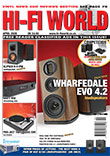Marantz SR8002 - Conclusion |
Page 2 of 2
CONCLUSION The SR8002 is a receiver with massive ability. It can process just about every form of digital audio thrown at it, including SACD, and as far as I am aware is future proof as a result. It is very unlikely higher resolution audio formats will appear on Blu-ray as current ones, such as 24/192 PCM haven't been taken up commercially as yet. We may get a surprise when the Blu-ray Profile 3 audio disc appears, but I doubt it because the music business has yet to migrate to 24/96 in 5.1, let alone anything of higher resolution. Still, when it arrives, the big Marantz can handle it all, delivering a fast, punchy sound underpinned by rock solid bass. It's a great performer and a very good choice for audiophiles, especially those with a valued SACD collection.
Big, revealing sound from a receiver that does it all, including SACD. MARANTZ SR8002 £1299 Marantz UK +44(0)1753 680868 FOR - Vivid, revealing sound - SACD decode - All latest digital formats AGAINST - Runs warm - Complicated remote - Average VHF sound
MEASURED PERFORMANCE Power measured 150 Watts into 8 Ohms, rising to 240 Watts into 4 Ohms, so the SR8002 is very powerful. With a high damping factor of 44 the Marantz will sound punchy yet controlled.
Distortion levels were low via the Direct 7.1 inputs, but there was a distinct crossover distortion pattern that gave an extended odd-order harmonic spectrum, seen in our spectrum analysis. This will give the sound a slightly sharp edge and a sense of incision, especially into 4 Ohm loudspeakers as a low load exacerbated the effect.
The stereo inputs, when sent through the A/D convertor in Auto mode, added little to distortion levels, but noise was a little high at -80dB. The real limitation here though is input overload, which occurred at just 1.9V, because of the A/D convertor. This is low for CD, as most output 2.2V or more, and Marantz fit a red overload warning light and optional attenuator, marked ATT, as a result. It’s always best to connect CD via a digital link to avoid this, as well as conversion errors, or use Direct to avoid surround processing.
The stereo line inputs are very sensitive, needing just 200mV for full output to be developed, so low output external phono stages will work well.
The VHF tuner has an upper midrange droop, likely caused by mpx filter mis-termination. This will give it a warm balance. There is some upper treble in the form of a peak our analysis shows, so detailing will be there and this will avoid dullness.
Distortion levels were a little high at 0.33% at 50% modulation, when 0.1% is common. Noise measured -72dB, much like most modern VHF tuners, and at this level it will be inaudible. The tuner needs 0.6mV for full quieting, a low value, and sensitivity was fairly good at 38uV for -50dB hiss in stereo. Selecting Mono allows just 2.4uV to be received with -50dB hiss. The VHF tuner works well, but it isn’t a top notch design.
The SR8002 is powerful and turns in a good set of results all round. NK AMPLIFIER Power 150 Watts 7.1 ch Direct input Frequency response 15Hz - 70kHz Separation 63dB Noise -100dB Distortion 0.024% Sensitivity 200mV TUNER Frequency response 26Hz - 16kHz Stereo separation 39dB Distortion (50% mod.) 0.33% Hiss (CCIR) -72dB Signal for minimum hiss 673µV Sensitivity mono 2.4µV stereo 38µV
VHF TUNER RESPONSE
DISTORTION
|








